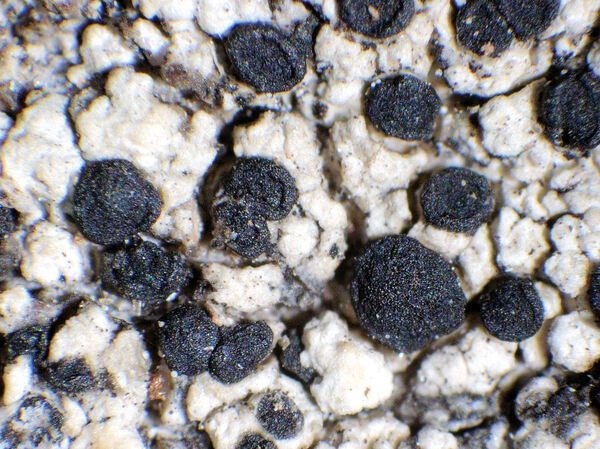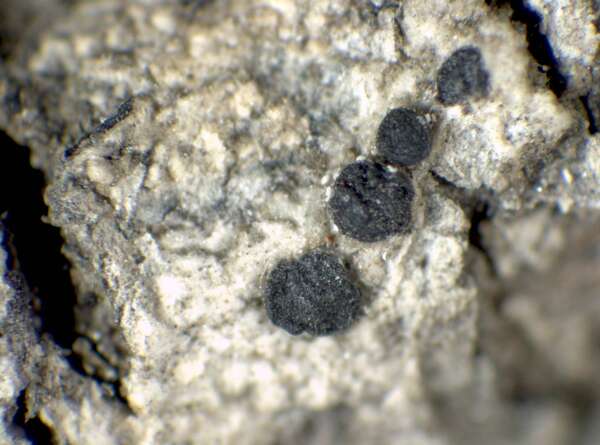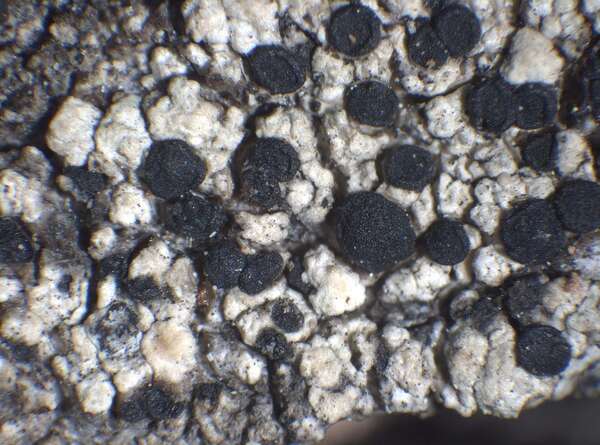Tetramelas chloroleucus (Körb.) A. Nordin
Lichenologist, 36: 356, 2004. Basionym: Buellia chloroleuca Körb. - Parerga Lichenol.: 191, 1860.
Synonyms: Buellia parasema var. saprophila (Ach.) Körb.; Buellia poeltii T. Schauer; Buellia punctata var. saprophila (Ach.) Anzi; Buellia zahlbruckneri sensu T. Schauer; Tetramelas poeltii (T. Schauer) Kalb
Description: Thallus crustose, episubstratic, granular to rimose-areolate, rather thin, dark to pale greenish grey or more rarely ochraceous, sometimes delimited by a black prothallus. Medulla white, lacking calcium oxalates, I-. Apothecia lecideine, black, 0.2-0.8(-1) mm across, soon sessile, with a flat to convex, epruinose disc, and a thin, soon excluded proper margin. Proper exciple narrow, c. 60 µm wide laterally, Aethalea-type, the inner hyphae hyaline, prosoplectenchymatous, the outer hyphae parallel and usually strongly brown-pigmented; epithecium brown; hymenium colourless, 80-90 µm high, not inspersed with oil droplets; paraphyses simple to moderately branched, apically swollen, with a brown pigment cap; hypothecium brown. Asci 8-spored, clavate to cylindrical-clavate, the apical dome K/I+ dark blue with a pale, conical-pointed apical cushion (axial mass), the wall I-, but the thin outer gel I+ blue, Bacidia-type. Ascospores 1-septate, brown, narrowly ellipsoid, not constricted at septa, sometimes slightly curved, (13-)16-20(-24) x (5.5-)7-9(-11) µm, Buellia-type, but sometimes slightly thickened at apices (Callispora-type when immature), the wall faintly microrugulate. Pycnidia rare, black, globose. Conidia bacilliform, 3-6.5 x 0.5-1 µm. Spot tests: K+ weakly yellow, C+ pale yellow-orange, KC+ orange, P-, UV+ weakly orange. Chemistry: 6-O-methylarthothelin, plus variable amounts of arthothelin with isoarthothelin, atranorin, and other xanthones.
Growth form: Crustose
Substrata: lignum
Photobiont: green algae other than Trentepohlia
Reproductive strategy: mainly sexual
Commonnes-rarity: (info)
Alpine belt: absent
Subalpine belt: rather rare
Montane belt: rare
Dry submediterranean belt: absent
Humid submediterranean belt: absent
Padanian area: absent
pH of the substrata:
1 2 3 4 5
Solar irradiation:
1 2 3 4 5
Aridity:
1 2 3 4 5
Eutrophication:
1 2 3 4 5
Poleotolerance:
0 1 2 3
Altitudinal distribution:
1 2 3 4 5 6
Rarity
absent
extremely rare
very rare
rare
rather rare
rather common
common
very common
extremely common
Loading data...
Occurrence data
Predictive map
Growth form: Crustose
Substrata: lignum
Photobiont: green algae other than Trentepohlia
Reproductive strategy: mainly sexual
Commonnes-rarity: (info)
Alpine belt: absent
Subalpine belt: rather rare
Montane belt: rare
Dry submediterranean belt: absent
Humid submediterranean belt: absent
Padanian area: absent
pH of the substrata:
| 1 | 2 | 3 | 4 | 5 |
Solar irradiation:
| 1 | 2 | 3 | 4 | 5 |
Aridity:
| 1 | 2 | 3 | 4 | 5 |
Eutrophication:
| 1 | 2 | 3 | 4 | 5 |
Poleotolerance:
| 0 | 1 | 2 | 3 |
Altitudinal distribution:
| 1 | 2 | 3 | 4 | 5 | 6 |
Rarity
absent
extremely rare
very rare
rare
rather rare
rather common
common
very common
extremely common
Loading data...
Occurrence data
Predictive map









